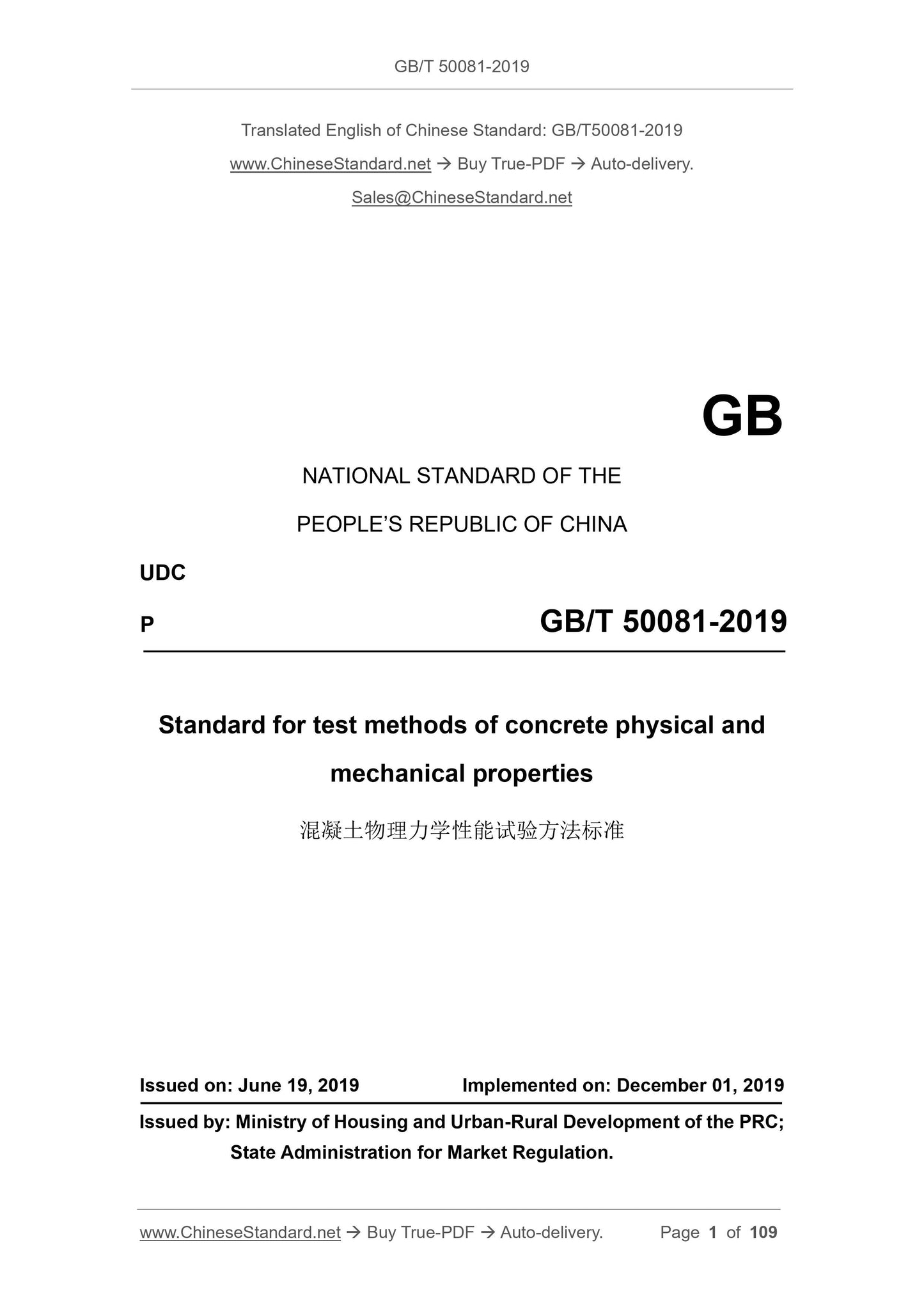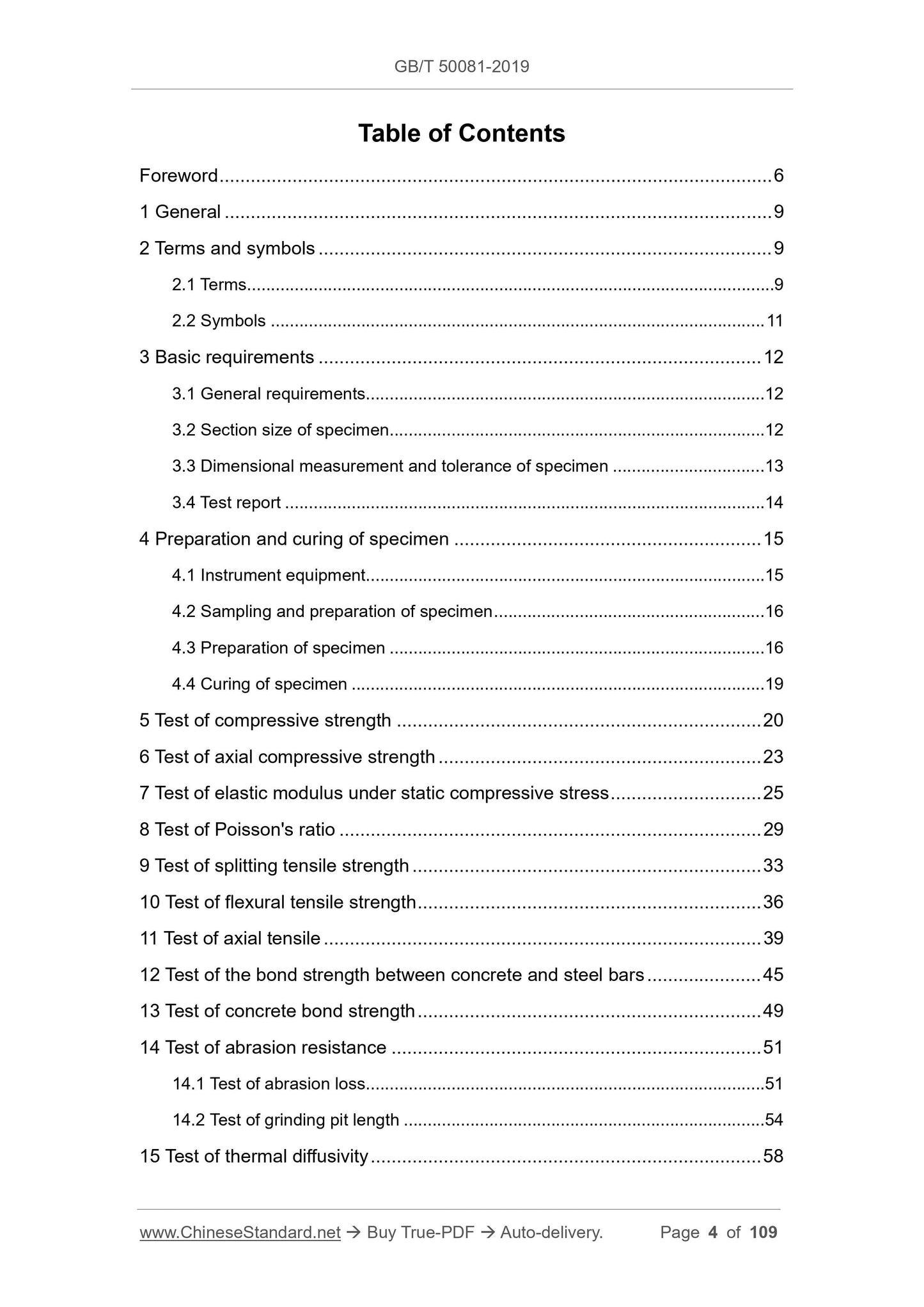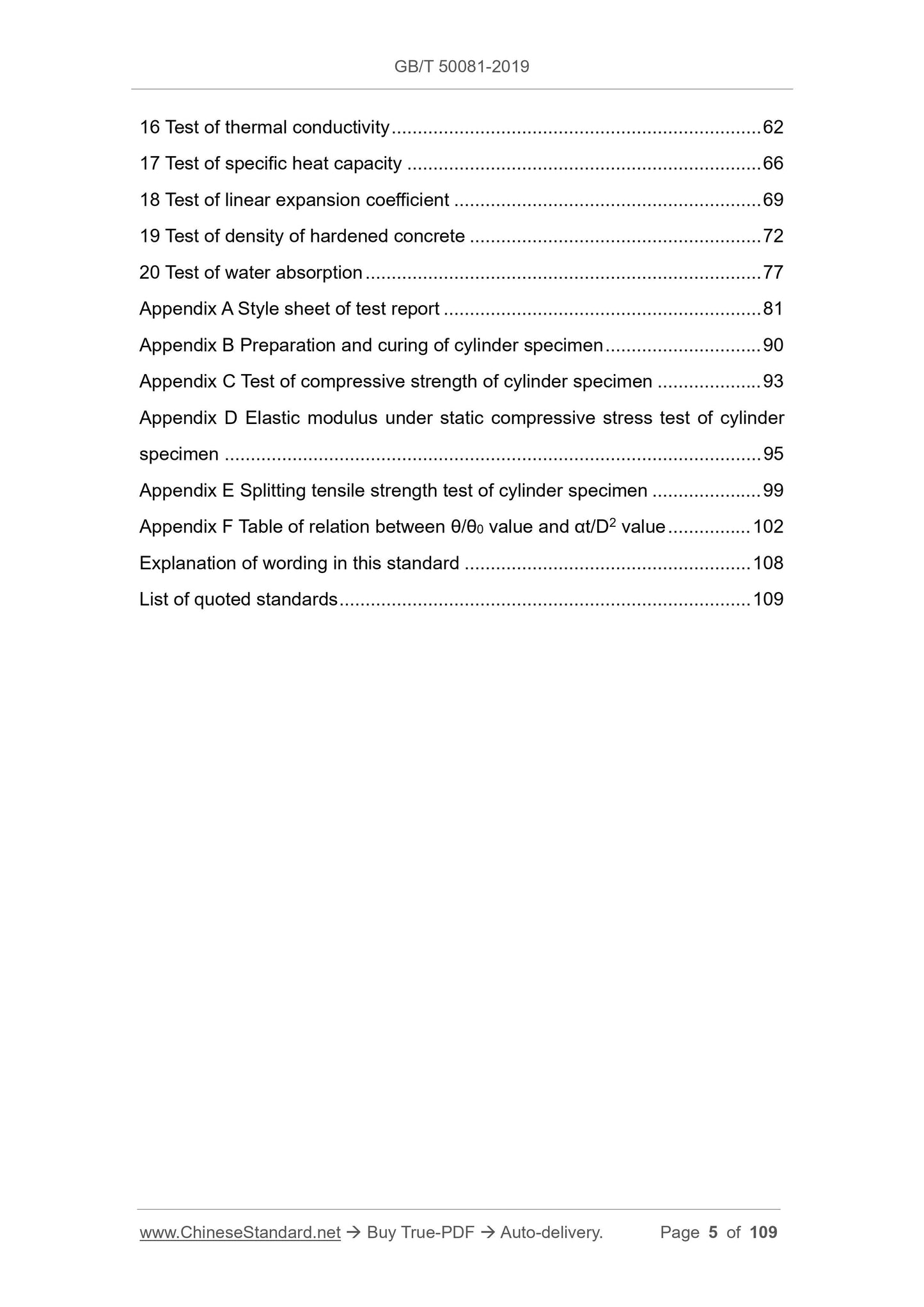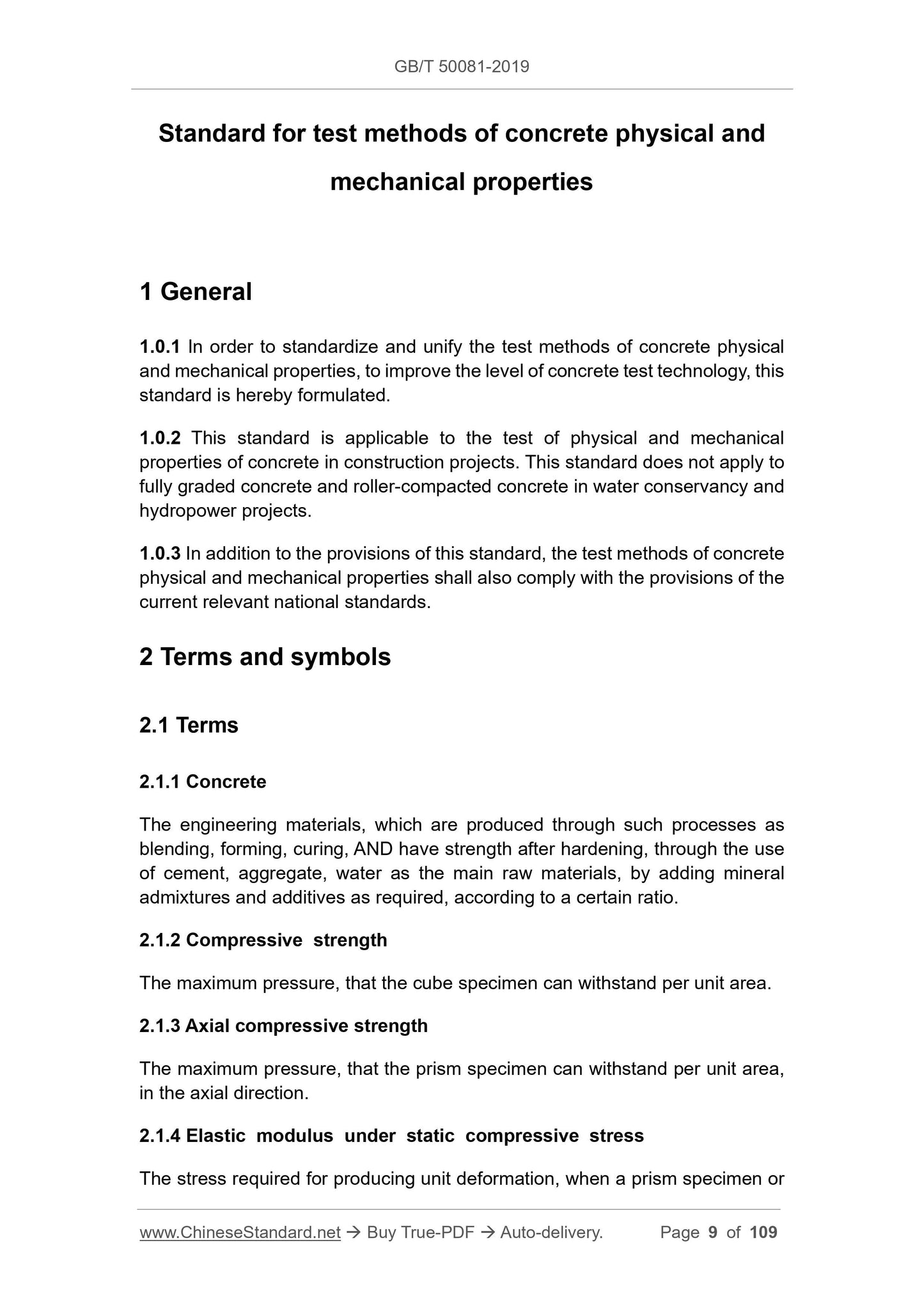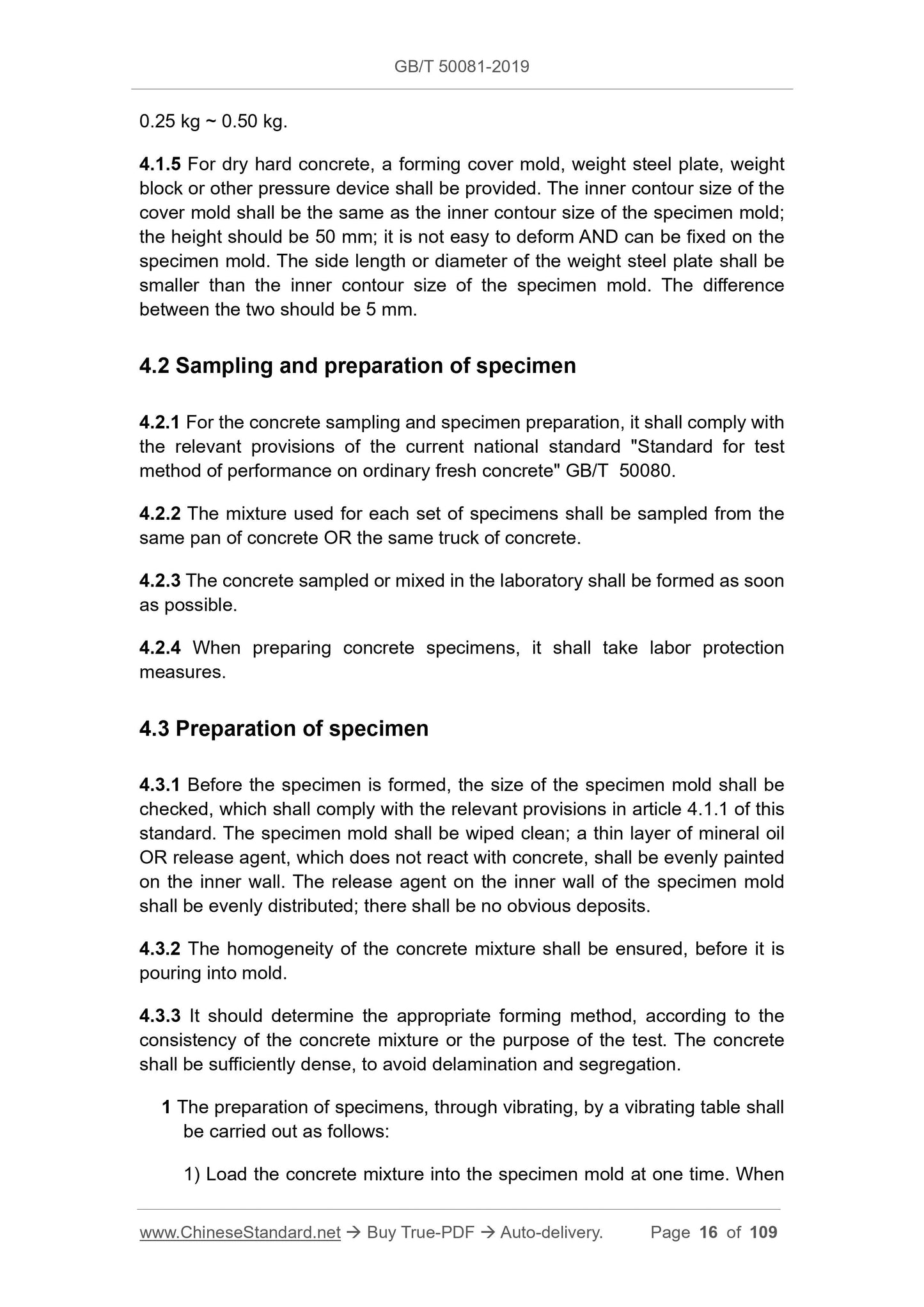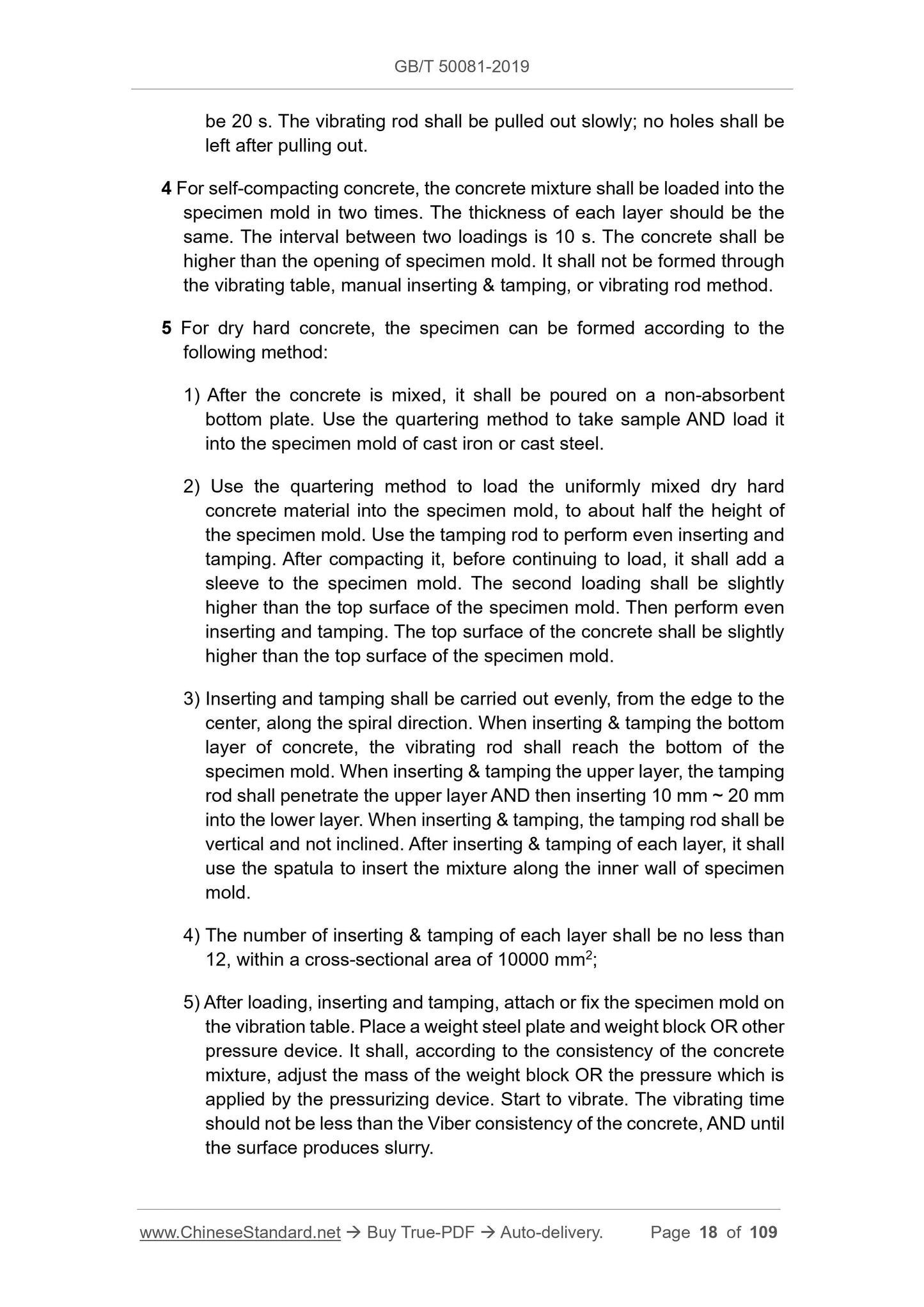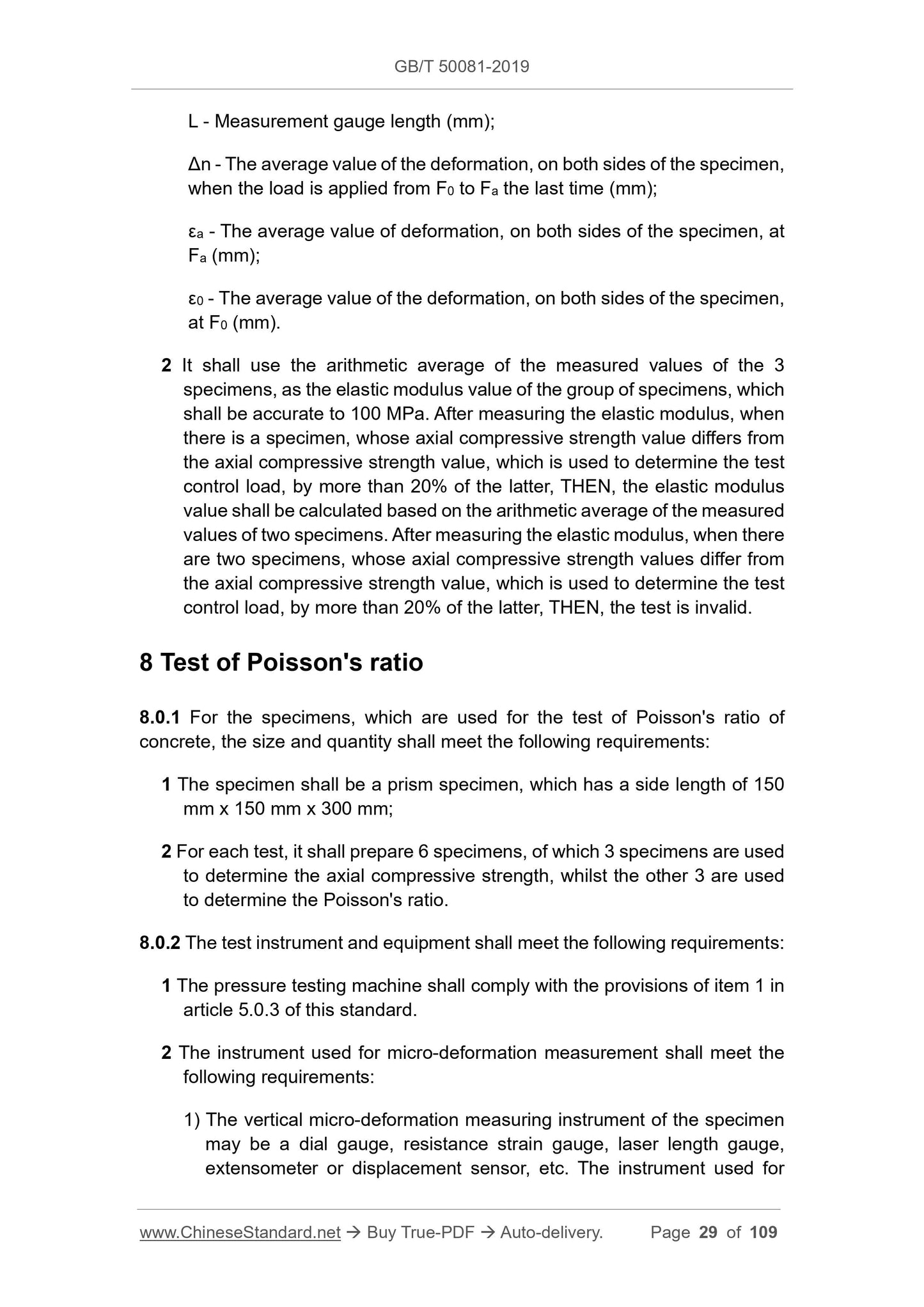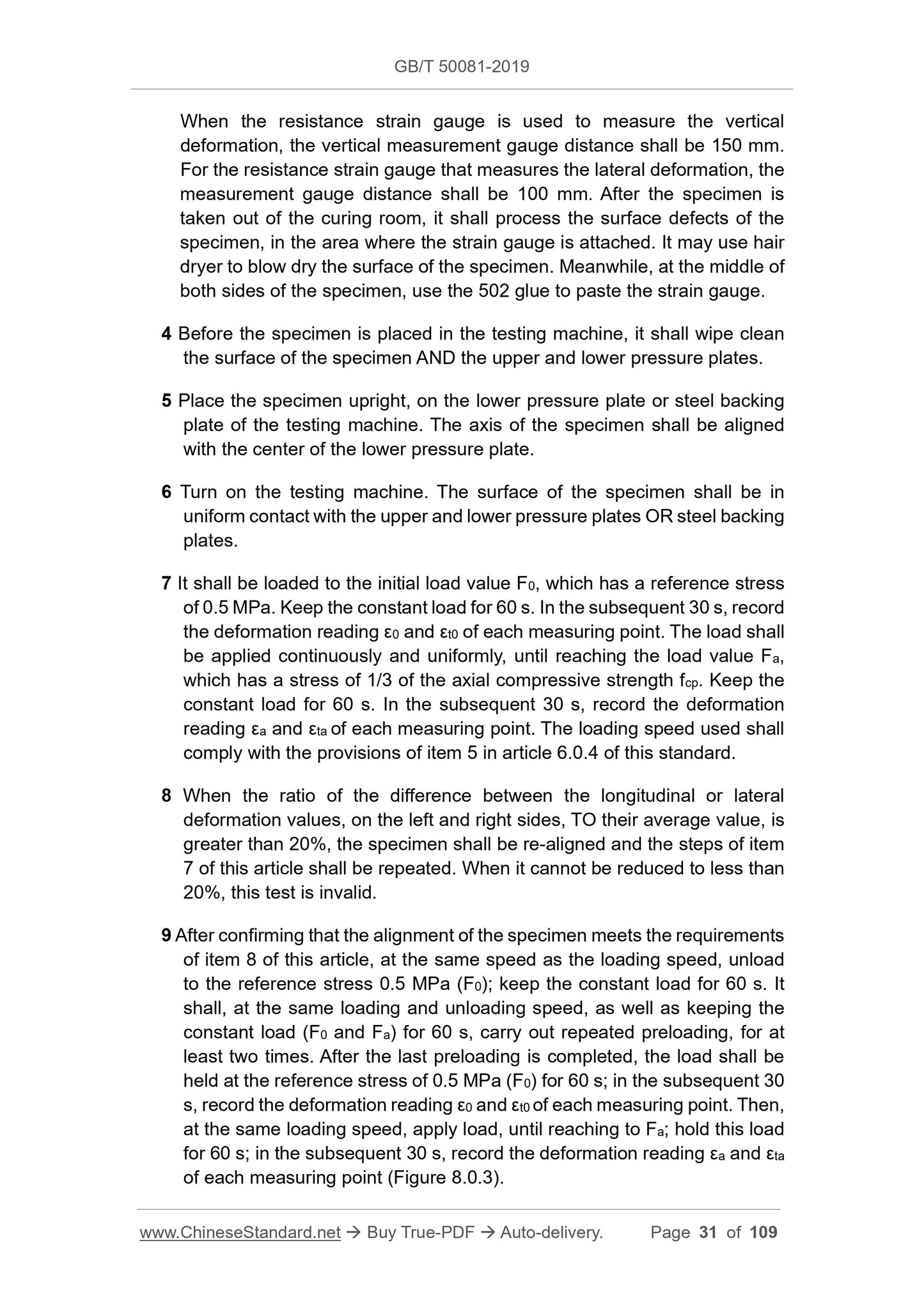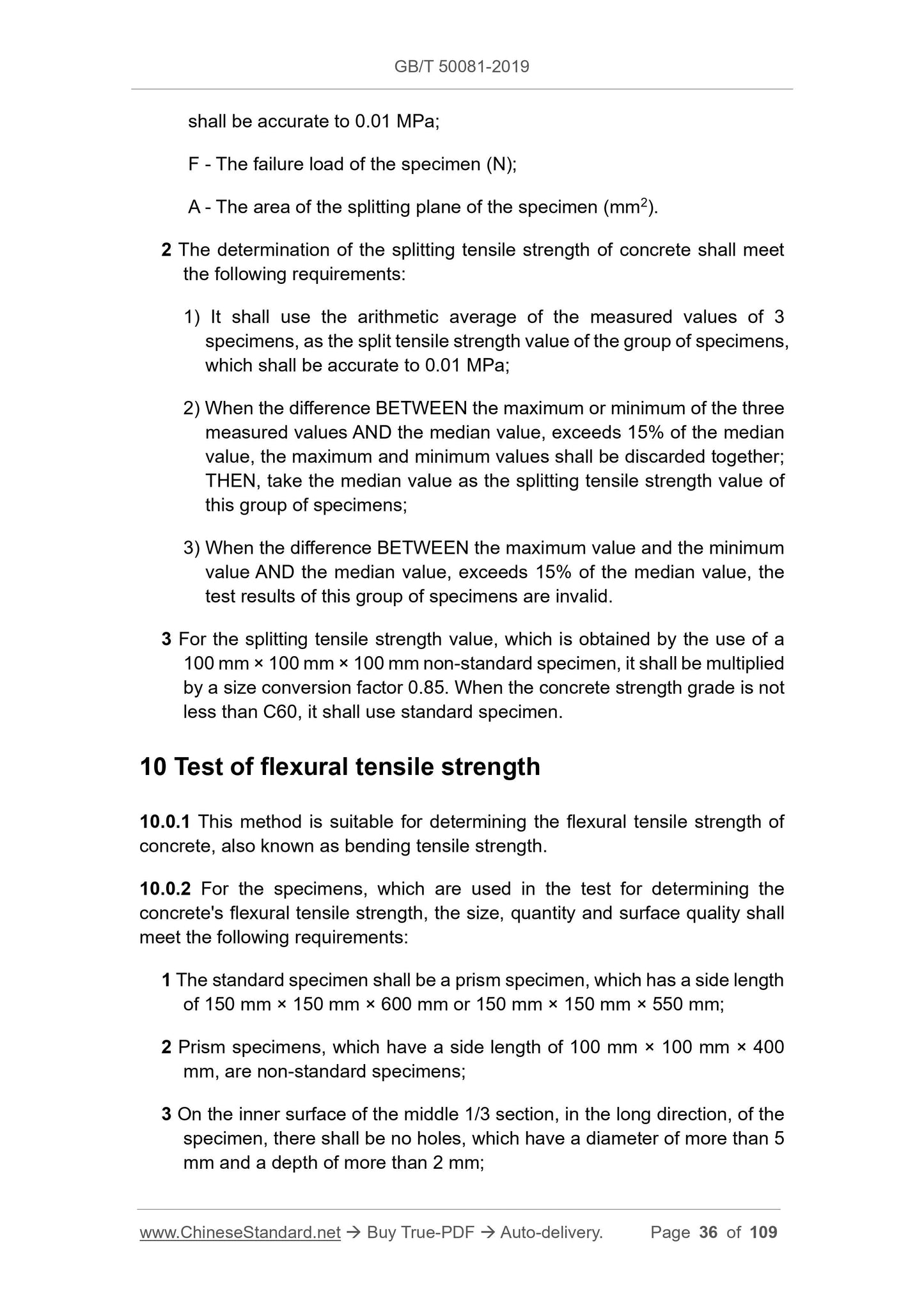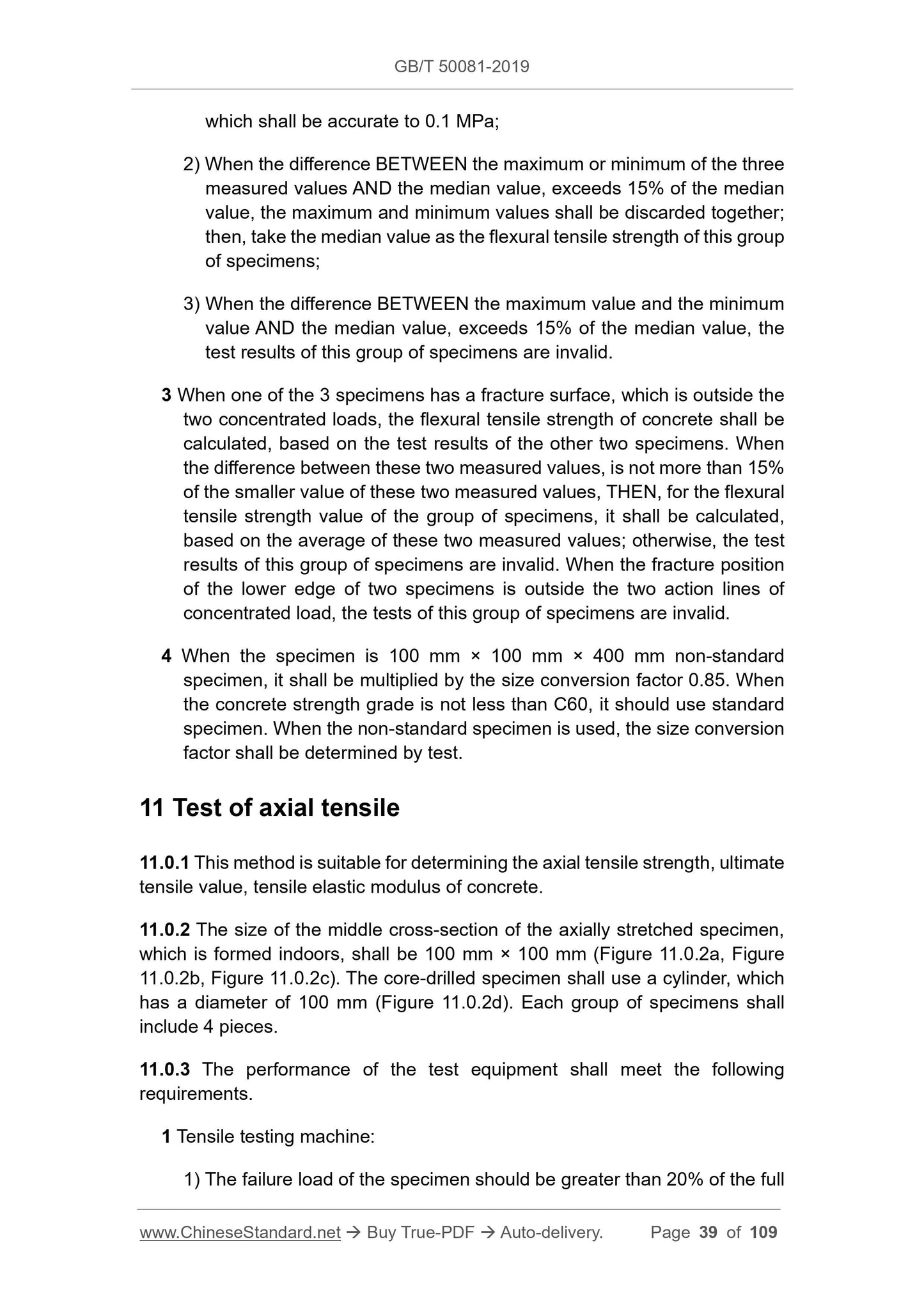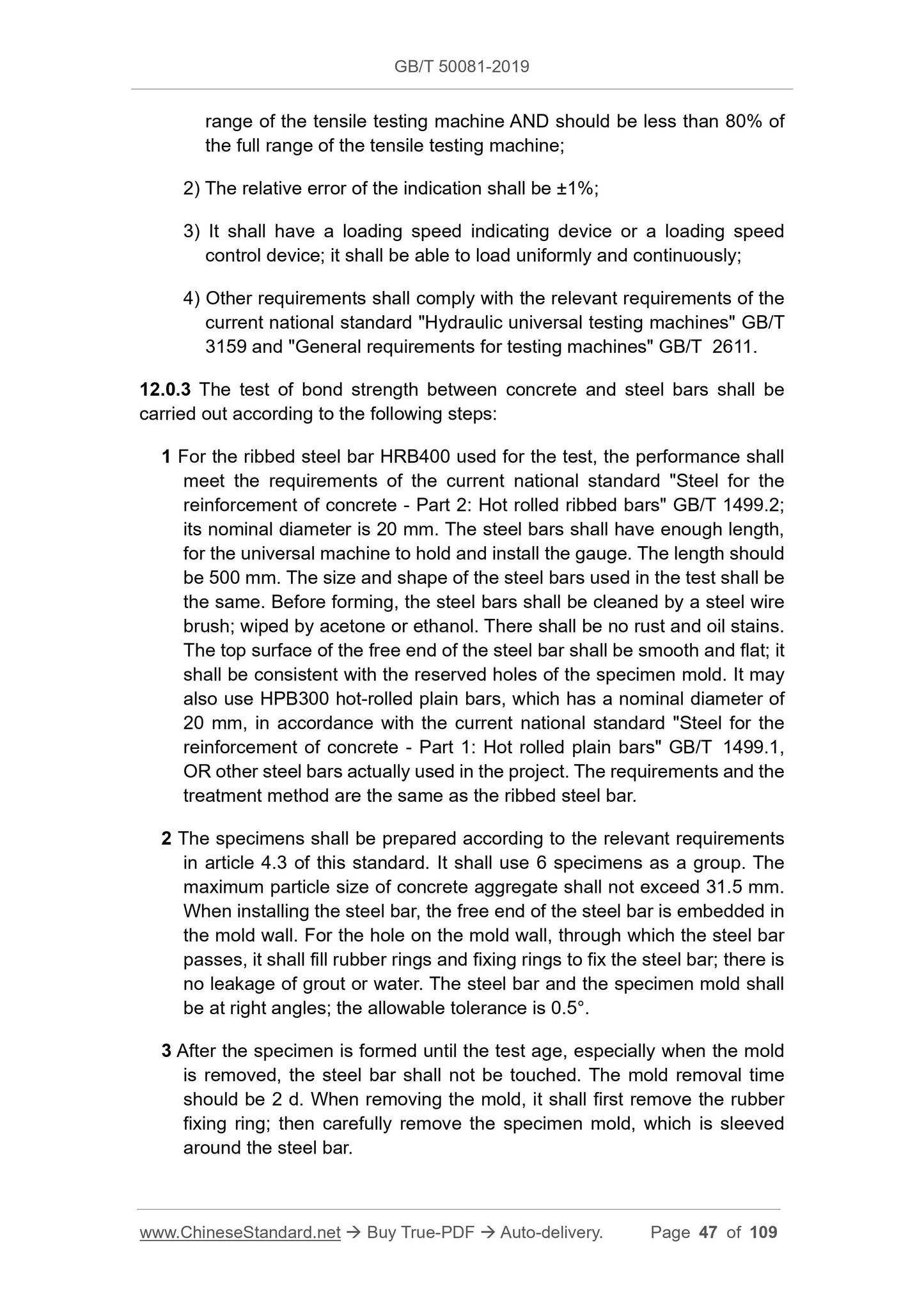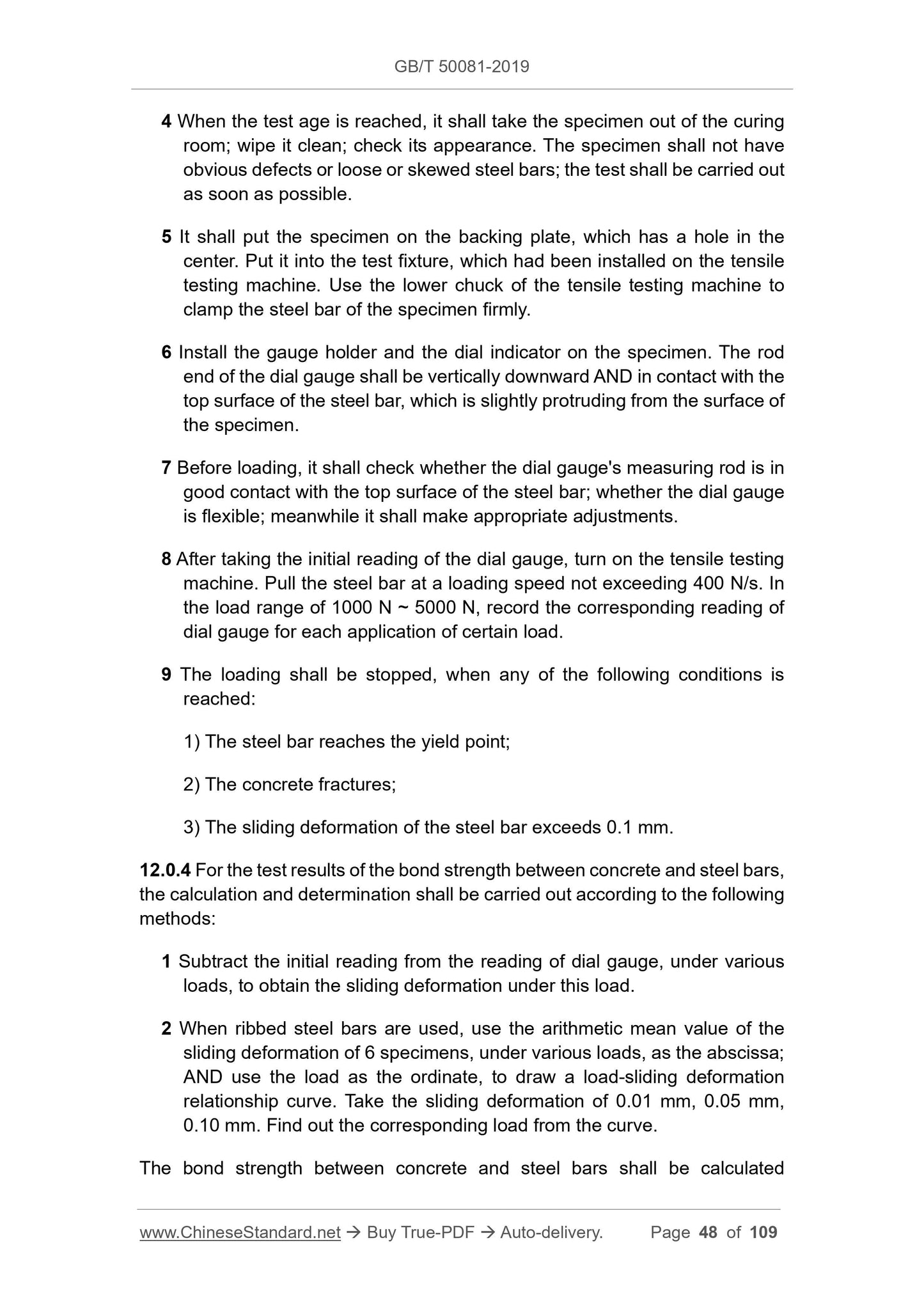1
/
of
12
PayPal, credit cards. Download editable-PDF and invoice in 1 second!
GB/T 50081-2019 English PDF (GBT50081-2019)
GB/T 50081-2019 English PDF (GBT50081-2019)
Regular price
$1,430.00 USD
Regular price
Sale price
$1,430.00 USD
Unit price
/
per
Shipping calculated at checkout.
Couldn't load pickup availability
Delivery: 3 seconds. Download true-PDF + Invoice.
Get QUOTATION in 1-minute: Click GB/T 50081-2019
Historical versions: GB/T 50081-2019
Preview True-PDF (Reload/Scroll if blank)
GB/T 50081-2019: Standard for test methods of concrete physical and mechanical properties
GB/T 50081-2019
GB
NATIONAL STANDARD OF THE
PEOPLE’S REPUBLIC OF CHINA
UDC
P GB/T 50081-2019
Standard for test methods of concrete physical and
mechanical properties
ISSUED ON: JUNE 19, 2019
IMPLEMENTED ON: DECEMBER 01, 2019
Issued by: Ministry of Housing and Urban-Rural Development of the PRC;
State Administration for Market Regulation.
Table of Contents
Foreword ... 6
1 General ... 9
2 Terms and symbols ... 9
2.1 Terms ... 9
2.2 Symbols ... 11
3 Basic requirements ... 12
3.1 General requirements... 12
3.2 Section size of specimen... 12
3.3 Dimensional measurement and tolerance of specimen ... 13
3.4 Test report ... 14
4 Preparation and curing of specimen ... 15
4.1 Instrument equipment... 15
4.2 Sampling and preparation of specimen ... 16
4.3 Preparation of specimen ... 16
4.4 Curing of specimen ... 19
5 Test of compressive strength ... 20
6 Test of axial compressive strength ... 23
7 Test of elastic modulus under static compressive stress ... 25
8 Test of Poisson's ratio ... 29
9 Test of splitting tensile strength ... 33
10 Test of flexural tensile strength ... 36
11 Test of axial tensile ... 39
12 Test of the bond strength between concrete and steel bars ... 45
13 Test of concrete bond strength ... 49
14 Test of abrasion resistance ... 51
14.1 Test of abrasion loss ... 51
14.2 Test of grinding pit length ... 54
15 Test of thermal diffusivity ... 58
16 Test of thermal conductivity ... 62
17 Test of specific heat capacity ... 66
18 Test of linear expansion coefficient ... 69
19 Test of density of hardened concrete ... 72
20 Test of water absorption ... 77
Appendix A Style sheet of test report ... 81
Appendix B Preparation and curing of cylinder specimen ... 90
Appendix C Test of compressive strength of cylinder specimen ... 93
Appendix D Elastic modulus under static compressive stress test of cylinder
specimen ... 95
Appendix E Splitting tensile strength test of cylinder specimen ... 99
Appendix F Table of relation between θ/θ0 value and αt/D2 value ... 102
Explanation of wording in this standard ... 108
List of quoted standards ... 109
Standard for test methods of concrete physical and
mechanical properties
1 General
1.0.1 In order to standardize and unify the test methods of concrete physical
and mechanical properties, to improve the level of concrete test technology, this
standard is hereby formulated.
1.0.2 This standard is applicable to the test of physical and mechanical
properties of concrete in construction projects. This standard does not apply to
fully graded concrete and roller-compacted concrete in water conservancy and
hydropower projects.
1.0.3 In addition to the provisions of this standard, the test methods of concrete
physical and mechanical properties shall also comply with the provisions of the
current relevant national standards.
2 Terms and symbols
2.1 Terms
2.1.1 Concrete
The engineering materials, which are produced through such processes as
blending, forming, curing, AND have strength after hardening, through the use
of cement, aggregate, water as the main raw materials, by adding mineral
admixtures and additives as required, according to a certain ratio.
2.1.2 Compressive strength
The maximum pressure, that the cube specimen can withstand per unit area.
2.1.3 Axial compressive strength
The maximum pressure, that the prism specimen can withstand per unit area,
in the axial direction.
2.1.4 Elastic modulus under static compressive stress
The stress required for producing unit deformation, when a prism specimen or
0.25 kg ~ 0.50 kg.
4.1.5 For dry hard concrete, a forming cover mold, weight steel plate, weight
block or other pressure device shall be provided. The inner contour size of the
cover mold shall be the same as the inner contour size of the specimen mold;
the height should be 50 mm; it is not easy to deform AND can be fixed on the
specimen mold. The side length or diameter of the weight steel plate shall be
smaller than the inner contour size of the specimen mold. The difference
between the two should be 5 mm.
4.2 Sampling and preparation of specimen
4.2.1 For the concrete sampling and specimen preparation, it shall comply with
the relevant provisions of the current national standard "Standard for test
method of performance on ordinary fresh concrete" GB/T 50080.
4.2.2 The mixture used for each set of specimens shall be sampled from the
same pan of concrete OR the same truck of concrete.
4.2.3 The concrete sampled or mixed in the laboratory shall be formed as soon
as possible.
4.2.4 When preparing concrete specimens, it shall take labor protection
measures.
4.3 Preparation of specimen
4.3.1 Before the specimen is formed, the size of the specimen mold shall be
checked, which shall comply with the relevant provisions in article 4.1.1 of this
standard. The specimen mold shall be wiped clean; a thin layer of mineral oil
OR release agent, which does not react with concrete, shall be evenly painted
on the inner wall. The release agent on the inner wall of the specimen mold
shall be evenly distributed; there shall be no obvious deposits.
4.3.2 The homogeneity of the concrete mixture shall be ensured, before it is
pouring into mold.
4.3.3 It should determine the appropriate forming method, according to the
consistency of the concrete mixture or the purpose of the test. The concrete
shall be sufficiently dense, to avoid delamination and segregation.
1 The preparation of specimens, through vibrating, by a vibrating table shall
be carried out as follows:
1) Load the concrete mixture into the specimen mold at one time. When
be 20 s. The vibrating rod shall be pulled out slowly; no holes shall be
left after pulling out.
4 For self-compacting concrete, the concrete mixture shall be loaded into the
specimen mold in two times. The thickness of each layer should be the
same. The interval between two loadings is 10 s. The concrete shall be
higher than the opening of specimen mold. It shall not be formed through
the vibrating table, manual inserting and tamping, or vibrating rod method.
5 For dry hard concrete, the specimen can be formed according to the
following method:
1) After the concrete is mixed, it shall be poured on a non-absorbent
bottom plate. Use the quartering method to take sample AND load it
into the specimen mold of cast iron or cast steel.
2) Use the quartering method to load the uniformly mixed dry hard
concrete material into the specimen mold, to about half the height of
the specimen mold. Use the tamping rod to perform even inserting and
tamping. After compacting it, before continuing to load, it shall add a
sleeve to the specimen mold. The second loading shall be slightly
higher than the top surface of the specimen mold. Then perform even
inserting and tamping. The top surface of the concrete shall be slightly
higher than the top surface of the specimen mold.
3) Inserting and tamping shall be carried out evenly, from the edge to the
center, along the spiral direction. When inserting and tamping the bottom
layer of concrete, the vibrating rod shall reach the bottom of the
specimen mold. When inserting and tamping the upper layer, the tamping
rod shall penetrate the upper layer AND then inserting 10 mm ~ 20 mm
into the lower layer. When inserting and tamping, the tamping rod shall be
vertical a...
Get QUOTATION in 1-minute: Click GB/T 50081-2019
Historical versions: GB/T 50081-2019
Preview True-PDF (Reload/Scroll if blank)
GB/T 50081-2019: Standard for test methods of concrete physical and mechanical properties
GB/T 50081-2019
GB
NATIONAL STANDARD OF THE
PEOPLE’S REPUBLIC OF CHINA
UDC
P GB/T 50081-2019
Standard for test methods of concrete physical and
mechanical properties
ISSUED ON: JUNE 19, 2019
IMPLEMENTED ON: DECEMBER 01, 2019
Issued by: Ministry of Housing and Urban-Rural Development of the PRC;
State Administration for Market Regulation.
Table of Contents
Foreword ... 6
1 General ... 9
2 Terms and symbols ... 9
2.1 Terms ... 9
2.2 Symbols ... 11
3 Basic requirements ... 12
3.1 General requirements... 12
3.2 Section size of specimen... 12
3.3 Dimensional measurement and tolerance of specimen ... 13
3.4 Test report ... 14
4 Preparation and curing of specimen ... 15
4.1 Instrument equipment... 15
4.2 Sampling and preparation of specimen ... 16
4.3 Preparation of specimen ... 16
4.4 Curing of specimen ... 19
5 Test of compressive strength ... 20
6 Test of axial compressive strength ... 23
7 Test of elastic modulus under static compressive stress ... 25
8 Test of Poisson's ratio ... 29
9 Test of splitting tensile strength ... 33
10 Test of flexural tensile strength ... 36
11 Test of axial tensile ... 39
12 Test of the bond strength between concrete and steel bars ... 45
13 Test of concrete bond strength ... 49
14 Test of abrasion resistance ... 51
14.1 Test of abrasion loss ... 51
14.2 Test of grinding pit length ... 54
15 Test of thermal diffusivity ... 58
16 Test of thermal conductivity ... 62
17 Test of specific heat capacity ... 66
18 Test of linear expansion coefficient ... 69
19 Test of density of hardened concrete ... 72
20 Test of water absorption ... 77
Appendix A Style sheet of test report ... 81
Appendix B Preparation and curing of cylinder specimen ... 90
Appendix C Test of compressive strength of cylinder specimen ... 93
Appendix D Elastic modulus under static compressive stress test of cylinder
specimen ... 95
Appendix E Splitting tensile strength test of cylinder specimen ... 99
Appendix F Table of relation between θ/θ0 value and αt/D2 value ... 102
Explanation of wording in this standard ... 108
List of quoted standards ... 109
Standard for test methods of concrete physical and
mechanical properties
1 General
1.0.1 In order to standardize and unify the test methods of concrete physical
and mechanical properties, to improve the level of concrete test technology, this
standard is hereby formulated.
1.0.2 This standard is applicable to the test of physical and mechanical
properties of concrete in construction projects. This standard does not apply to
fully graded concrete and roller-compacted concrete in water conservancy and
hydropower projects.
1.0.3 In addition to the provisions of this standard, the test methods of concrete
physical and mechanical properties shall also comply with the provisions of the
current relevant national standards.
2 Terms and symbols
2.1 Terms
2.1.1 Concrete
The engineering materials, which are produced through such processes as
blending, forming, curing, AND have strength after hardening, through the use
of cement, aggregate, water as the main raw materials, by adding mineral
admixtures and additives as required, according to a certain ratio.
2.1.2 Compressive strength
The maximum pressure, that the cube specimen can withstand per unit area.
2.1.3 Axial compressive strength
The maximum pressure, that the prism specimen can withstand per unit area,
in the axial direction.
2.1.4 Elastic modulus under static compressive stress
The stress required for producing unit deformation, when a prism specimen or
0.25 kg ~ 0.50 kg.
4.1.5 For dry hard concrete, a forming cover mold, weight steel plate, weight
block or other pressure device shall be provided. The inner contour size of the
cover mold shall be the same as the inner contour size of the specimen mold;
the height should be 50 mm; it is not easy to deform AND can be fixed on the
specimen mold. The side length or diameter of the weight steel plate shall be
smaller than the inner contour size of the specimen mold. The difference
between the two should be 5 mm.
4.2 Sampling and preparation of specimen
4.2.1 For the concrete sampling and specimen preparation, it shall comply with
the relevant provisions of the current national standard "Standard for test
method of performance on ordinary fresh concrete" GB/T 50080.
4.2.2 The mixture used for each set of specimens shall be sampled from the
same pan of concrete OR the same truck of concrete.
4.2.3 The concrete sampled or mixed in the laboratory shall be formed as soon
as possible.
4.2.4 When preparing concrete specimens, it shall take labor protection
measures.
4.3 Preparation of specimen
4.3.1 Before the specimen is formed, the size of the specimen mold shall be
checked, which shall comply with the relevant provisions in article 4.1.1 of this
standard. The specimen mold shall be wiped clean; a thin layer of mineral oil
OR release agent, which does not react with concrete, shall be evenly painted
on the inner wall. The release agent on the inner wall of the specimen mold
shall be evenly distributed; there shall be no obvious deposits.
4.3.2 The homogeneity of the concrete mixture shall be ensured, before it is
pouring into mold.
4.3.3 It should determine the appropriate forming method, according to the
consistency of the concrete mixture or the purpose of the test. The concrete
shall be sufficiently dense, to avoid delamination and segregation.
1 The preparation of specimens, through vibrating, by a vibrating table shall
be carried out as follows:
1) Load the concrete mixture into the specimen mold at one time. When
be 20 s. The vibrating rod shall be pulled out slowly; no holes shall be
left after pulling out.
4 For self-compacting concrete, the concrete mixture shall be loaded into the
specimen mold in two times. The thickness of each layer should be the
same. The interval between two loadings is 10 s. The concrete shall be
higher than the opening of specimen mold. It shall not be formed through
the vibrating table, manual inserting and tamping, or vibrating rod method.
5 For dry hard concrete, the specimen can be formed according to the
following method:
1) After the concrete is mixed, it shall be poured on a non-absorbent
bottom plate. Use the quartering method to take sample AND load it
into the specimen mold of cast iron or cast steel.
2) Use the quartering method to load the uniformly mixed dry hard
concrete material into the specimen mold, to about half the height of
the specimen mold. Use the tamping rod to perform even inserting and
tamping. After compacting it, before continuing to load, it shall add a
sleeve to the specimen mold. The second loading shall be slightly
higher than the top surface of the specimen mold. Then perform even
inserting and tamping. The top surface of the concrete shall be slightly
higher than the top surface of the specimen mold.
3) Inserting and tamping shall be carried out evenly, from the edge to the
center, along the spiral direction. When inserting and tamping the bottom
layer of concrete, the vibrating rod shall reach the bottom of the
specimen mold. When inserting and tamping the upper layer, the tamping
rod shall penetrate the upper layer AND then inserting 10 mm ~ 20 mm
into the lower layer. When inserting and tamping, the tamping rod shall be
vertical a...
Share
